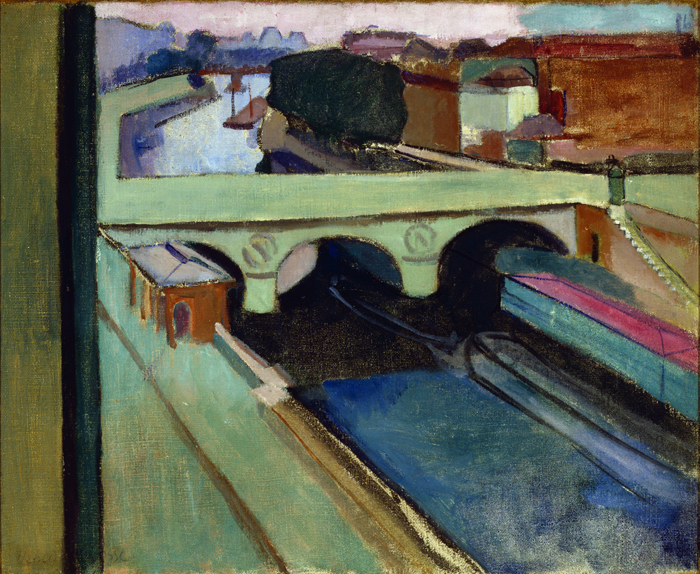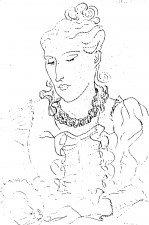Click here to see four additional views of Pont Saint-Michel painted by Matisse.

Henri Matisse
French, 1869-1954
Pont Saint-Michel, 1901 ca.
oil on canvas
23 ¾ x 28 ¾ in.
SBMA, Bequest of Wright S. Ludington
1993.1.5

Matisse in his Paris studio, photo by Alvin Langdon Coburn.
RESEARCH PAPER
At the turn of the twentieth century, Henri Matisse, a young Parisian artist and student of Gustave Moreau, was beginning a lifetime of work that would span six decades and include various experimental methods of painting. His long odyssey in search of the beautiful would take many years of personal experimentation to evolve and develop, but his early indebtedness to the Impressionists and Paul Cezanne cannot be ignored. The Impressionists emancipated pure, bright colors for Matisse while Cezanne liberated form for him, as seen in Matisse’s early sculptures and paintings.
It is remarkable that the Matisse we are familiar with, both in imagery and vivid brightness, spent his youth in the colorless, damp countryside of Le Cateau, a locale that was an improbable stimulant for the development of an artist who was to be later hailed as one “destined to simplify color.”
The period between 1900 and 1914 was marked by a series of revolutionary innovations, experimentations and trends in the French art world. What was in vogue one year was out the next. By 1900, Matisse too was trying many different styles and mediums. Although impressionism no longer offered a solution to the problems addressed by many aspiring young artists, Matisse internalized and expanded the freedom that the Impressionists loosened and the spark of the color explosion was lit.
In 1900 Matisse was living in Paris with his wife and child at 19 quai St. Michel in an apartment that overlooked the river Seine and the Pont St. Michel. He offers that view in an early oil on canvas painted at the turn of the century, titled “Pont Saint Michel.” It is one of numerous paintings that Matisse made at this time using various styles to portray the view from his apartment window.
The SBMA version of this view is distinguished by its thinly painted clear mauves, greens and pinks. The perspective is down the Seine River with the viewer’s eye being drawn to the distant city. The bridge shadows and pink sky portend the setting sun. This brightness evolves. There is a mood of quiet pensiveness created by lack of people and the massive architectural forms. There are forceful geometric shapes and strong linear lines, especially the dark border strip on the left side of the picture. Note also the horizontal line of the bridge and the opposite diagonal bank of the river that together add two more emphatic compositional lines as well as dimensional motion to the overall construct. The relationship between the lines and angles of the picture’s structure are softened by the curved contours of the bridge’s three arches. There are no complimentary shadows. The pavilions of the Louvre and the Palace of Justice are seen in the distant skyline. The totality gives a feeling of what a particular day might look like from Matisse’s apartment window.
In one of his other views of the Pont Saint Michel he shows a bright view of a sun bathed city which is in sharp contrast to the SBMA quiet and somber version. In it Matisse uses the short brush strokes of the Impressionists giving what appears to be a quick rendition of the bridge. Although his pictures often appear as if they were created with quick ease, he has revealed that he “…had to work hard to hide his labors.”
Prepared for the Santa Barbara Museum of Art Docent Council by Suedell Powell, May, 1993. Adapted for the Docent website by Jerry Jensen, June, 2004.
Bibliography
Barr, Alfred H., Matisse His Art and His Public, New York: Arno Press
Museum of Modern Art, 1951, The Museum of Modern Art, New York, Matisse A Retrospective, September 24, 1992 – January 12, 1993
Russell, John and the Editors of Time-Life Books. The World of Matisse 1869-1954, Time Inc., 1969
Schneider, Pierre. Matisse, Rizzali International Publications, Inc., 1984
POSTSCRIPT
In 2012 the Pompidou organized an exhibition called “Matisse, Pairs and Series” which traveled to the Metropolitan. Our "Pont Saint-Michel” was included with two other paintings of the same scene. There are still more variations, all ca. 1900-01. They are in private collections except for ours. (Thank you, Wright Ludington.) Matisse was experimenting, and the view from his studio window was a readily available subject.
In about 1900 Matisse attempted to absorb all the currents in the art world. He went to London in 1898 following Pissaro’s advice to study the work of J.M.W. Turner. From 1899 he worked at Quai Michel with his friend and fellow painter, Albert Marquet. He bought paintings by artists he wanted to study, including Gauguin, Van Gogh, and Cezanne. In 1902-03 he would paint in a pointillist style with Paul Signac, and in 1904-05 he would paint abstract color with Andre Derain.
Our painting of 1901 is related to these later colorist paintings, termed Fauve, even though ours is serene, even dreamlike. The painting looks down at the Seine and back toward the horizon from Matisse’s studio at #19 Quai Michel. The Ile de la Cite is on the right. On the left is a window frame. Matisse simplified forms. No traffic is on the river, street, or bridge, and no windows are in the buildings or barge. The artist did not use light and shadow for modeling. The bridge and quai, for example, are a single green shape. Matisse also experimented with color. He painted intense darks and chose hues that are not naturalistic. His lines are both drawn with a brush and created by shapes. Thin irregular paint reveals areas of canvas or color under-neath. The real subject is the painting itself, its composition and color. For example, the strong vertical of the window frame keeps the eye from leaving at the left. The bright pink barge roof helps hold the right corner and echoes the left distance. Warm color contrasts and balances with cool, etc. Abstraction interacts with representation.
In 1900 Matisse, 31, had been in Paris for ten years. He had begun his studies in 1891 at the Acadamie Julian (under Bouguereau) but had transferred to the studio of Moreau, a symbolist and follower of Delacroix. In his academic training he copied works of Chardin. In 1896 his arrival in the French art world was marked by the acceptance of five works inspired by his study of Chardin into the Société Nationale exhibit. In 1896-97, however, Matisse himself credited an Australian painter who was working in France, John Peter Russell, with teaching him color theory. Our painting of 1901 dates from the very beginning of Matisse’s forte as the century’s great colorist.
- Ellen Lawson, February, 2015

GUIDE BY CELL
Guide by Cell Script
Jeff Vitucci
• What we are looking at here is Henri Matisse’s Pont Saint-Michel, or St. Michel’s Bridge. It is an oil on canvas, painted in 1901 when Matisse and his family were living in their Paris apartment overlooking the River Seine and the subject bridge.
• This scene shows one of the several bridges that cross the Seine, in this case, one of the bridges that connects the west bank of Paris, on the left side of the painting, to the Île de la Cité on the right. Paris’s Notre Dame cathedral would be found off to the right outside the frame of the painting.
• We know it was a scene from his apartment window since he obligingly, and interestingly, included the window casement of his apartment on the left side of the composition.
• This painting is a good example of the evolving styles of painting that emerged around the turn of the century. While this painting still falls within the post-impressionist period, it shows Matisse's early experiments with fauvism and, soon thereafter, expressionism. The Expressionists were somewhat dissatisfied with what they saw as the limits of the observable world and experimented freely with the distortion of form and color in the portrayal of their subjects. For example, the painting is a mixture of mauves, greens, and pinks – colors not necessarily seen from his view of the river from his apartment window.
• For instance, we can be sure that the bridge was not the pale green hue represented in this scene. Likewise, we can pretty much be assured the barge docked on the far side of the river did not have a pink roof. Color and form were, to the artist, sufficient to convey or invoke emotions to or in the viewers.
• Further, we also see in this piece the idea of radical simplicity, the idea that a painting should be reduced to its essential forms and exclude any unnecessary features. Note there are no people in the scene, no traffic on the river, buildings with no windows. Again, it is the idea of form and color which is important.
• As an aside, Matisse painted at least four other versions of this scene from his apartment window, always experimenting with different colors and level of detail.
SBMA CURATORIAL LABELS
In emulation of Monet’s and Pissarro’s work in series, Matisse painted multiple canvases from the window of his fifth-floor apartment, overlooking the Seine. This painting, with its radical simplification of forms and luminous palette, shows the artist’s rapid development away from the more traditional techniques he had absorbed as an art student and towards the radical solutions he admired in the art of Cézanne, van Gogh, and Rodin. The heightened palette and flattened decorative surface of this landscape would soon give way to an even more lurid and fantastical use of color in the coming years, culminating in the artist’s breakthrough Fauve (“wild beast”) years (1904-1906).
- Ridley-Tree Gallery 2016
